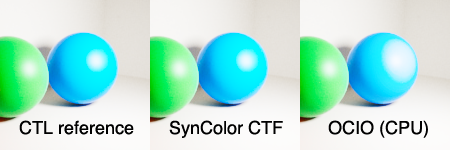Hi Derek
I agree with what Nick wrote above, the whitened area will vary with the color of the object due to the different behavior of the various rendering transforms (ACES, spi-anim, ARRI, etc.) as colors move off the top of the gamut.
That said, although the OCIO ACES config is quite good, it sounds like you’re running into a known issue – as colors get very bright they lose accuracy.
I’m attaching an example image so others can follow what we’re talking about. This is a region of your EXR, with the exposure gained up by 5x. On the left is the result of the Academy sRGB Output Transform CTL (ground truth), in the middle is what Maya/Flame/Lustre would give (SynColor CTF), and on the right is what the ACES config in OCIO would give. (I specified the OCIO CPU renderer since the OCIO GPU renderer has other known problems.) You can see that the Maya result matches the CTL reference but the OCIO result is wrong in the blue highlights.
Regarding your question about Nuke, currently there is no easy way to apply a CTF in Nuke. You could bake it out into a LUT, but then you’d run into the same problems that the OCIO config has. The reason the CTF works better is because it is more of an “exact math” implementation of the ACES CTL code rather than baking down into a LUT-based representation.
However, the SynColor SDK is included in the Maya DevKit, so it is possible to write plug-ins that would allow you to apply CTFs (and therefore ACES transforms) at full accuracy (and high speed) in other applications. I know some facilities have done this but I realize it requires more work than one would like.
best regards,
Doug Walker
Autodesk
